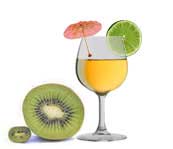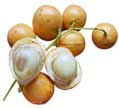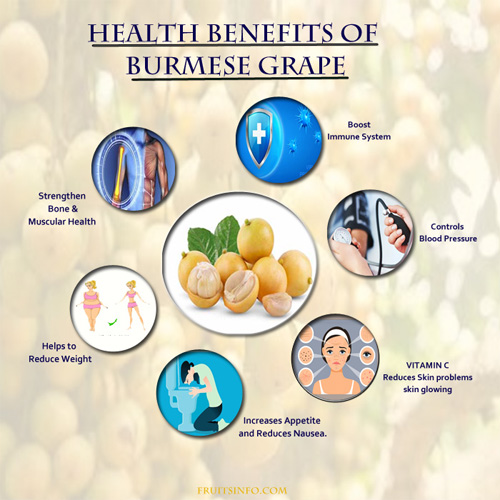 Full List of Fruits
Full List of Fruits  Burmese Grape
Burmese Grape
Burmese Grapes
Scientific name - Baccaurea ramiflora
Origin - It is found throughout Asia, most commonly cultivated in India and Malaysia.
Appearance - Mafai or Burmese grape is an egg-shaped, yellowish colored, pinkish to bright red or purple fruit. This is a small and a juicy fruit with good taste. The fruit grows up to 2.5-3.5 cm in diameter with white aril. The fruit consists of 2-4 large purple-red seed. This is a small and a juicy fruit with good flavor.
Most of the fruit contain ascorbic acid, enzymes, bioflavonoids. The fruit is rich in minerals like chromium, potassium, and magnesium etc as well as B vitamins to amino acids. The largest amount of iron, 5.34 mg/100g was observed in Burmese-grape,
- The fruit is usually eaten fresh, poached or made into wine.
- The seeds are edible as well.
- Though it is most commonly cultivated in India and Malaysia, it is also found throughout Asia.
- The trees are usually found at a low density.
- The fruit is harvested and used locally.
- This can be used in variety of colors as a tinned or a sweetened fruit topping.
- Eating too many fruits makes your stomach get upset.
- More often it is nurtured in home gardens and intercropped with fruits like durian, rambutan and mango.
- The trees have a poor regeneration capacity.
- The tree shows a good example for the fruits which grows directly from the main trunk.
1) It is used medicinally to treat skin diseases.
2) The roots, bark and wood are harvested for medicinal uses.
It is a medium-sized evergreen tree which reaches up to 20-25 m in height, with a round and a shady crown. This is used as a refreshing nibble or as a table fruit. Bark, roots and wood of the fruit are dried and ground before boiling it. Fruits can be kept fresh for around 4-5 days, or else it can be boiled and mixed with salt after which when kept in an air tight container can be used for longer time. Marginal importance of the fruit is that it can be used locally and can also be sold.
They are the oblate fruits hanging in big trees; from the bottom of the branches to the top of the trees. They are so large in number that they even bend the branches. Some are green, some are yellow and some are red, they look like balls engraved with jades or beads made of agates. The fruits have a succulent, sour and sweet taste.
How to eat the fruit? To consume the fruit first we have to break the fruit by peeling off the skin. After that the pulp can be eaten directly, mostly the seeds are also swallowed.
1. Burmese Grape Wine

Ingredients:
- 1/2 kg Burmese Grape
- 1 kg sugar
- 5 cups of water
- 1/4 teaspoon yeast
Method:
- Peel the fruit and take the flesh outside.
- Boil the flesh of the fruit, sugar and water together in a bowl.
- Remove it from flame.
- Allow it to cool down by 30 degrees.
- After it got cooled add the yeast to it.
- Once its completely cooled, pour it into a clean, sun-dried bottle.
- Close the bottle with an air-tight fitting cap.
- Seal for 22 days.
- After 22 days, strain out the wine through a fine cloth (folded into 4-5 layers).
- Keep this strained wine in an airtight container for another 22 days before use.
- This wine has an original golden colour.
- Tasty wine is ready to serve.












 Nutrients in Burmese Grapes
Nutrients in Burmese Grapes Notes on Burmese Grapes
Notes on Burmese Grapes 




